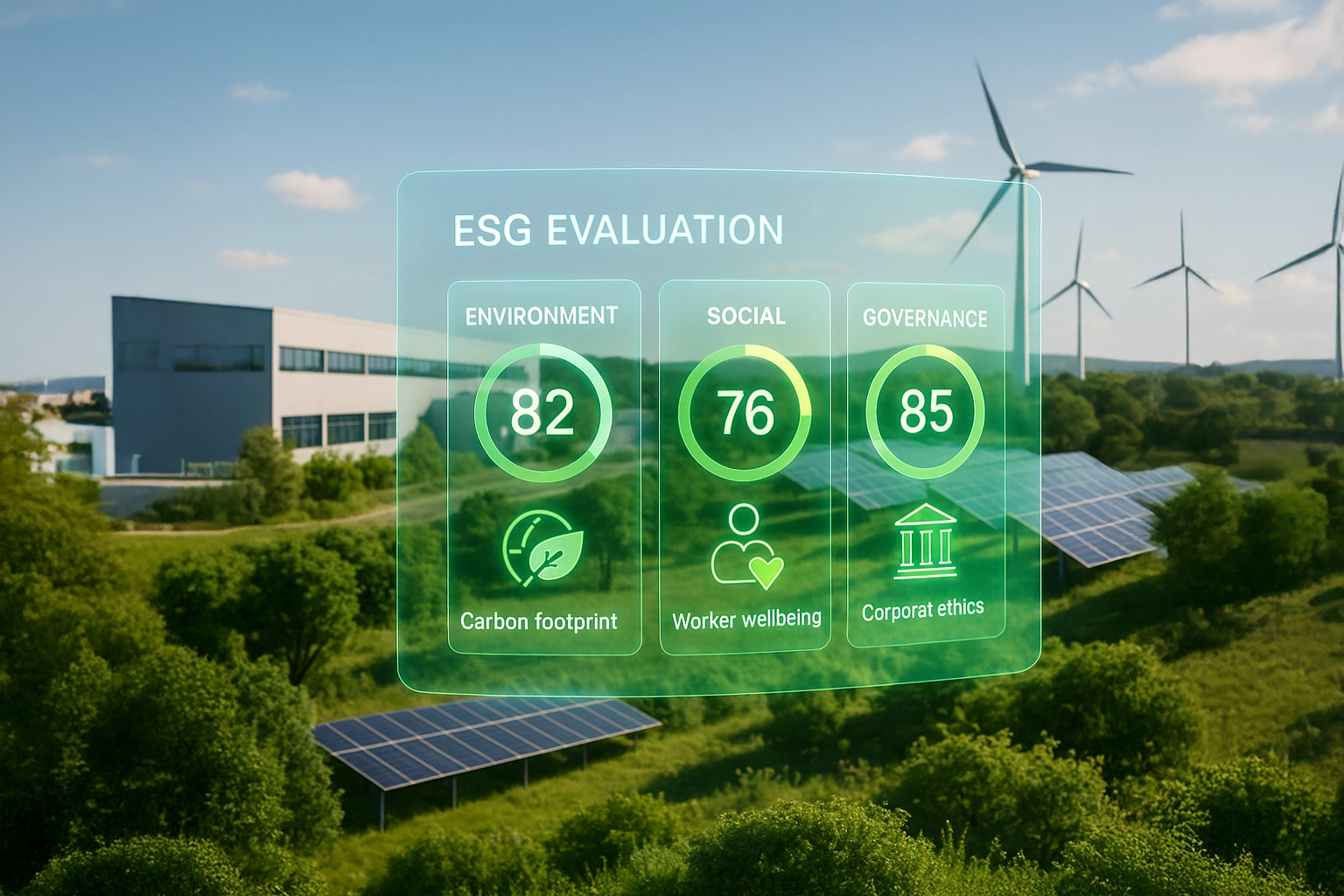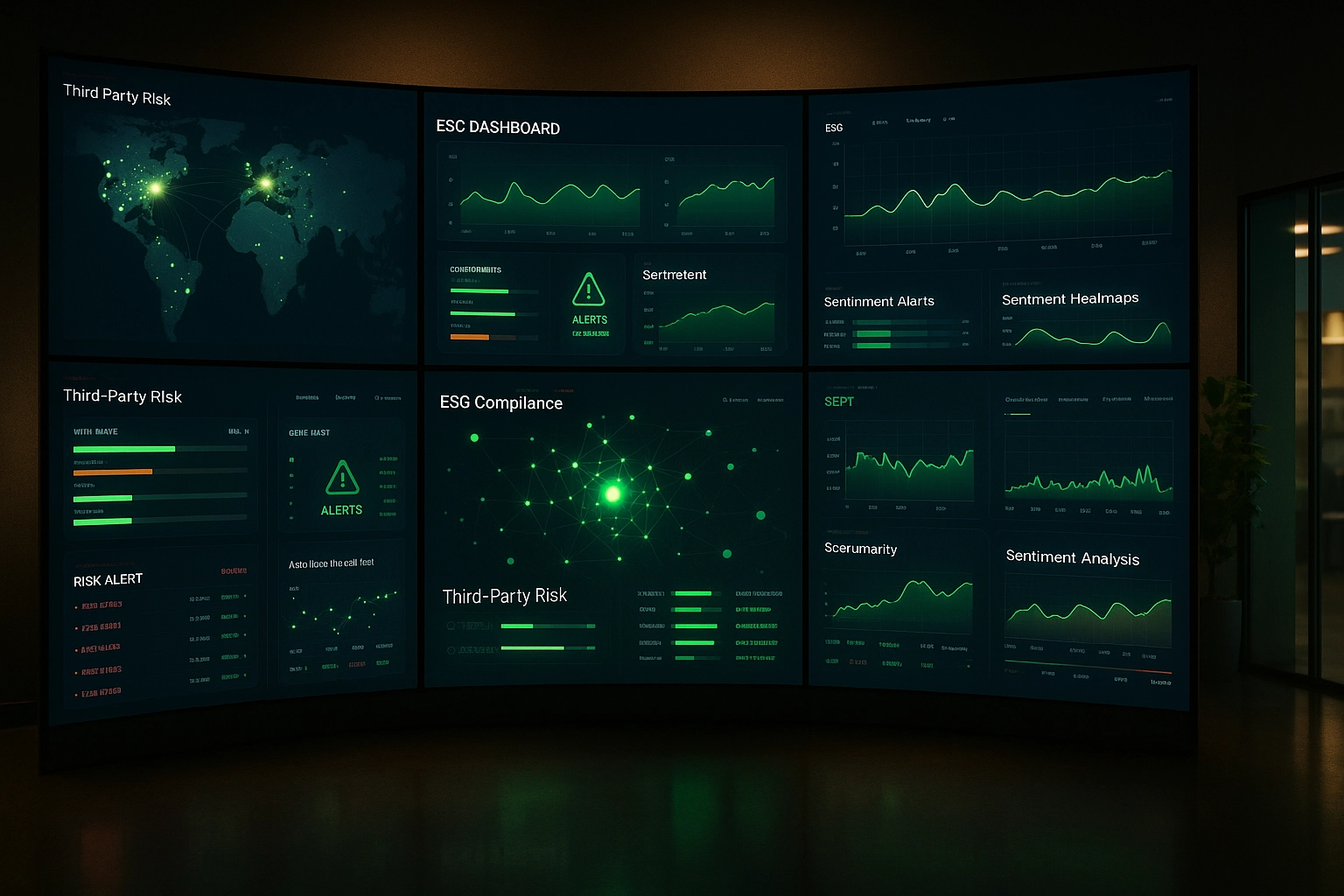Integrating ESG Criteria into Supplier Evaluation

Integrating environmental, social, and governance (ESG) criteria into the evaluation of third-party partners has become essential for companies seeking to strengthen their operational resilience and promote sustainable development. These criteria make it possible to analyze not only economic performance but also the environmental and social impact of business relationships. According to a recent McKinsey study, 83% of business leaders now see ESG as a long-term value driver rather than a mere regulatory obligation.
Understanding the Importance of ESG Criteria
Today, ESG criteria are a cornerstone of effective third-party governance. This approach goes far beyond regulatory compliance; it commits organizations to examine how their business partners positively or negatively influence their overall ecosystem.
Adopting a collaborative ESG criteria evaluation strengthens corporate governance standards and improves transparency. In the social housing sector, for example, landlords that implemented structured evaluations of their maintenance service providers saw a 37% reduction in non-compliance incidents, according to the Union Sociale pour l’Habitat.
| Traditional Approach | Collaborative Approach |
|---|---|
| Redundant audits | Data pooling |
| High administrative burden | Reduced supplier fatigue |
| Ad-hoc evaluations | Continuous monitoring |
Impact on Third-Party Governance
Integrating ESG criteria into the evaluation of third-party partners is an effective strategy to strengthen operational resilience. By measuring the ESG performance of its partners, a company can identify potential vulnerabilities earlier and put the necessary support measures in place. This includes environmental issues such as energy efficiency, as well as social aspects like working conditions.
In the construction sector, third-party governance takes on a particularly critical dimension when managing multi-tier subcontractors. As highlighted by OPPBTP and Umgo-FFB in their prevention partnership, “companies specializing in masonry and structural work have demonstrated their commitment through numerous prevention initiatives, with notable progress in many areas.” This collaborative approach effectively identifies occupational risks and improves operational resilience on worksites.
Go further
To learn more about subcontractor management in construction, read our article on Decarbonization in Construction: Challenges and Solutions for Subcontractors and Craftsmen.
This proactive approach helps avoid disruptions in the value chain and ensures operational continuity. It also contributes to enhancing the company’s reputation by demonstrating a tangible commitment to responsible business practices, while significantly reducing supplier fatigue through shared evaluation data.
Key Criteria for ESG Supplier Evaluation
When evaluating third-party partners according to ESG standards, several factors must be considered to ensure effective third-party governance. Typically, this evaluation revolves around three main pillars—environment, social, and governance—each contributing to greater operational resilience.
Environmental Criteria
Environmental criteria assess the ecological impact of a third party’s activities. A comprehensive evaluation should include:
- CO₂ emission reduction and decarbonization strategies
- Use of renewable energy sources in production processes
- Responsible waste management and circular economy initiatives
- Pollution prevention and environmental management systems
In the industrial sector, these criteria carry particular weight due to ICPE and REACH regulations. Service pooling between industrial players is a powerful lever for triggering the sector’s ecological transition. This industrial ecology approach directly addresses the emission reduction targets set by France’s National Low-Carbon Strategy, which aims to cut greenhouse gas emissions by a factor of six by 2050 compared to 1990 levels.
A robust third-party governance framework helps build trust with stakeholders and ensures integrity is at the core of every business transaction, thereby strengthening the operational resilience of the entire ecosystem.
Social Criteria
Social criteria evaluate the impact of third-party activities on their employees and society at large. They include:
- Occupational health and safety with measurable performance indicators
- Diversity and inclusion in HR policies
- Employee development and continuous training
- Respect for human rights across the value chain
In the social housing sector, these criteria are particularly scrutinized. According to a recent study by the Union Sociale pour l’Habitat, integrating social clauses into maintenance service contracts has become standard practice, enabling better working conditions while reducing non-compliance incidents. This reflects a broader trend of organizations strengthening engagement with third parties to better align them with their ESG strategy.
Governance Criteria
Governance aspects relate to how an organization is run, focusing on:
- Business ethics and anti-corruption policies
- Transparency in business practices and reporting
- Conflict of interest management and independence of decision-making bodies
- Regulatory compliance and anticipation of legal developments
In the retail sector, these criteria have become essential for managing risks linked to international marketplaces. According to IBM, “by ensuring suppliers comply with quality standards and regulatory requirements, a company can avoid costly recalls and legal penalties,” protecting its reputation while ensuring customers receive high-quality products and services.
Want to deepen your understanding of ESG challenges in your supply chain?
Read our full analysis on new ESG and supply chain challenges for 2025 and stay ahead of regulatory changes.
Practical Implementation of ESG Evaluations
To integrate ESG criteria effectively into third-party evaluation, it’s essential to adopt a structured, collaborative approach. Here’s a four-step methodology for implementing a robust ESG evaluation process:
- Set clear compliance policies – Define specific ESG requirements by partner category and sector. Top-performing ESG companies start with a standardized evaluation framework, with criteria weighted according to the partner’s strategic importance.
- Implement a systematic evaluation process – Develop a standardized scoring system to assess inherent and residual risks. According to Risk Management Magazine, this approach identifies partners requiring deeper evaluation and verifies mitigation effectiveness.
- Automate data collection and analysis – Use technology tools to centralize ESG information. According to Manutan, 69% of buyers now consider ethical practices and environmental/social performance when selecting new suppliers—an 18-point increase in just two years.
- Delegate data entry to partners – Use sector-specific self-assessment questionnaires and checklists. This empowers partners while feeding KPIs into your evaluation system.
In the industrial sector, this translates to deploying intelligent, customized workflows that automatically analyze third-party certifications and documentation, significantly reducing evaluation time while improving reliability.
Supporting Third Parties in the ESG Transition
Helping third parties improve their ESG performance is key to building mutually beneficial relationships. Concrete actions include:
- Conduct an initial collaborative assessment – Establish a clear baseline to measure future progress, identifying areas for improvement.
- Provide tailored measurement tools – Equip partners with tools to track carbon emissions and other ESG KPIs. These tools should centralize data management, customize data collection, and identify priority focus areas.
- Offer personalized consulting services – Provide tailored guidance, sector-specific initiatives, and detailed documentation. In retail, this can include sharing best practices and implementing technical support programs.
- Encourage knowledge sharing – Create platforms for exchanging best practices and experiences among partners. As Corcentric notes, assessing partners’ current ESG maturity is essential to designing a support program tailored to their specific needs.
This pooling of data and sector intelligence not only strengthens third-party compliance but also creates a more sustainable, resilient ecosystem for all stakeholders.
Benefits for Companies Adopting ESG Standards
Integrating ESG criteria into third-party evaluation delivers numerous strategic advantages well beyond regulatory compliance. A recent Frontiers in Environmental Science study found that companies with strong ESG performance see significant long-term financial gains.
Implementing robust third-party governance with ESG integration enables better operational risk management. In retail, this translates into a significant reduction in risks related to international supply chains. According to ESG News, ESG data allows retailers to address issues in inventory planning, supply chain sustainability, and manufacturing inefficiencies.
Adopting ESG standards also enhances operational resilience to future challenges. As Kinetic Consulting points out, this approach not only improves efficiency by reducing waste and conserving resources, but also boosts employee engagement and strengthens the company’s appeal to top talent.
By embracing a collaborative, ESG-based third-party evaluation approach, companies benefit from greater transparency, improved stakeholder reputation, and privileged access to financial markets. Supported by an integrated platform and deep sector expertise, this method ensures European data sovereignty and proactive adaptation to regulatory developments, positioning the company as a responsible leader in its sector.
Ready to implement an effective ESG evaluation of your third-party partners?
Discover how Aprovall can support you in meeting your new due diligence obligations under the European CS3D Directive and securing your supply chain.
These articles might interest you
-
 14 September 2024Aprovall supports you in your new due diligence obligations arising from the European CS3D Directive.SolutionsThe Corporate Sustainability Due Diligence Directive, known as “CS3D”, was definitively adopted on Wednesday, April 24, 2024, by the European Parliament. The directive now needs to be officially approved by the Council and signed before being published in the EU Official Journal. It will enter into force 20 days later. Member States will then have […]
14 September 2024Aprovall supports you in your new due diligence obligations arising from the European CS3D Directive.SolutionsThe Corporate Sustainability Due Diligence Directive, known as “CS3D”, was definitively adopted on Wednesday, April 24, 2024, by the European Parliament. The directive now needs to be officially approved by the Council and signed before being published in the EU Official Journal. It will enter into force 20 days later. Member States will then have […]Read more
-
 08 July 2025Why integrate media monitoring into your third-party evaluation?SolutionsWith the rapid acceleration of digital information and the proliferation of media sources, real-time monitoring of your third-party partners’ media presence has become a critical strategic issue. Media monitoring is now an essential part of collaborative evaluation processes for any analyst seeking a comprehensive view of third-party risk. Whether the information is positive or negative, […]
08 July 2025Why integrate media monitoring into your third-party evaluation?SolutionsWith the rapid acceleration of digital information and the proliferation of media sources, real-time monitoring of your third-party partners’ media presence has become a critical strategic issue. Media monitoring is now an essential part of collaborative evaluation processes for any analyst seeking a comprehensive view of third-party risk. Whether the information is positive or negative, […]Read more
-
 03 March 2025Understanding Dynamic Risk Scoring: Fundamentals and Implementation for Third-Party GovernanceSolutionsDynamic risk scoring has become an essential tool for organizations seeking to optimize their third-party governancestrategies. With increasingly complex partnerships and growing regulatory requirements in Europe—particularly DORA and NIS 2—it is crucial to understand how this methodology transforms collaborative assessment of third-party partners. According to data reported by Sprinto, 58% of compliance teams identify assessing third-party responsiveness as their main challenge […]
03 March 2025Understanding Dynamic Risk Scoring: Fundamentals and Implementation for Third-Party GovernanceSolutionsDynamic risk scoring has become an essential tool for organizations seeking to optimize their third-party governancestrategies. With increasingly complex partnerships and growing regulatory requirements in Europe—particularly DORA and NIS 2—it is crucial to understand how this methodology transforms collaborative assessment of third-party partners. According to data reported by Sprinto, 58% of compliance teams identify assessing third-party responsiveness as their main challenge […]Read more
-
 05 March 2025Maximizing the Impact of Dynamic Risk Scoring: Monitoring and Personalization for Effective Third-Party Risk ManagementSolutionsIn our previous article, we explored the fundamentals of dynamic risk scoring and its essential role in evolving third-party governance practices. This innovative approach, leveraging real-time data and sophisticated analytical models, is profoundly transforming the way organizations assess their third-party partners. As European regulatory requirements tighten with DORA, NIS 2, and the convergence of CSRD/Duty of Vigilance, organizations must […]
05 March 2025Maximizing the Impact of Dynamic Risk Scoring: Monitoring and Personalization for Effective Third-Party Risk ManagementSolutionsIn our previous article, we explored the fundamentals of dynamic risk scoring and its essential role in evolving third-party governance practices. This innovative approach, leveraging real-time data and sophisticated analytical models, is profoundly transforming the way organizations assess their third-party partners. As European regulatory requirements tighten with DORA, NIS 2, and the convergence of CSRD/Duty of Vigilance, organizations must […]Read more
